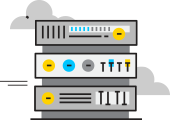An exploit chain refers to a sequence of multiple software vulnerabilities and techniques that are chained together to compromise a target system. It involves the exploitation of one or more vulnerabilities in a step-by-step manner to achieve a specific goal, such as gaining unauthorized access, executing malicious code, or escalating privileges. In this article, we will explore the concept of an exploit chain as it relates to the website of the proxy server provider OneProxy (oneproxy.pro).
The history of the origin of Exploit chain and the first mention of it
The concept of an exploit chain has been around for decades, evolving alongside the rapid advancements in computer technology and cybersecurity. The earliest mentions of exploiting multiple vulnerabilities in a chain can be traced back to the 1980s and 1990s, where hackers and security researchers started discovering and combining software weaknesses to gain unauthorized access to systems.
Detailed information about Exploit chain. Expanding the topic Exploit chain
Exploit chains are sophisticated attacks that involve a combination of various techniques, including but not limited to:
- Remote Code Execution (RCE): The attacker exploits a vulnerability to execute malicious code on a remote system.
- Privilege Escalation: After gaining initial access, the attacker exploits another vulnerability to elevate their privileges on the target system.
- Lateral Movement: Once inside a network, the attacker moves laterally to explore and compromise other systems.
- Persistence: The attacker ensures they can maintain access to the compromised system over an extended period.
- Defense Evasion: Techniques are used to bypass security mechanisms like firewalls and antivirus programs.
The internal structure of the Exploit chain. How the Exploit chain works
The internal structure of an exploit chain can be understood as a series of steps or stages. Here is a general overview of how an exploit chain works:
- Reconnaissance: The attacker gathers information about the target system and identifies potential vulnerabilities.
- Initial Exploitation: The attacker leverages the identified vulnerabilities to gain a foothold in the system.
- Privilege Escalation: The attacker seeks ways to elevate their privileges to gain more control over the system.
- Lateral Movement: If necessary, the attacker moves laterally across the network to explore and compromise other connected systems.
- Persistence: The attacker establishes mechanisms to maintain access to the compromised system.
- Malicious Payload: Finally, the attacker deploys a malicious payload to achieve their specific objective, which could include data theft, data destruction, or further compromising the system.
Analysis of the key features of Exploit chain
Key features of an exploit chain include:
- Sophistication: Exploit chains are highly sophisticated and require deep technical expertise to develop and execute successfully.
- Multiple Vulnerabilities: The chain targets multiple vulnerabilities, making it more difficult to defend against.
- Stealthy: Exploit chains often employ techniques to remain undetected by security systems and experts.
- Specific Objectives: Exploit chains are tailored to achieve specific goals, making them highly targeted attacks.
Types of Exploit chain
| Type | Description |
|---|---|
| Zero-Day Exploits | Exploits targeting previously unknown vulnerabilities, giving defenders no time to respond with patches. |
| Watering Hole Attacks | The attacker compromises a website that the target is likely to visit, infecting it with malware. When the target visits the site, the chain is triggered. |
| Phishing-Based Exploits | The chain starts with a phishing email containing a malicious attachment or link. If the target falls for the phishing attempt, the chain is initiated. |
| Browser Exploit Chains | Exploits targeting web browsers, leveraging multiple vulnerabilities in the browser and associated plugins. |
Exploit chains have both malicious and defensive applications. On the malicious side, cybercriminals use exploit chains to conduct sophisticated cyberattacks, including:
- Espionage and data theft.
- Ransomware attacks to encrypt and extort money from victims.
- Advanced Persistent Threats (APTs) for long-term infiltration and monitoring.
On the defensive side, security researchers and ethical hackers use exploit chains to:
- Identify and patch vulnerabilities in software and systems.
- Test the security posture of organizations to strengthen their defenses.
Problems related to exploit chains include the risk of:
- Exploiting unknown vulnerabilities, leading to zero-day attacks.
- Causing significant damage due to the multiple vulnerabilities targeted.
- Difficulty in detecting and mitigating such complex attacks.
Solutions to address these problems include:
- Regularly updating and patching software to reduce the risk of unknown vulnerabilities.
- Employing multi-layered security defenses to detect and block various stages of an exploit chain.
- Conducting thorough security assessments and penetration testing to identify and remediate weaknesses.
Main characteristics and other comparisons with similar terms in the form of tables and lists
| Characteristic | Exploit Chain | Exploit | Vulnerability |
|---|---|---|---|
| Nature | Sequence of vulnerabilities | Single vulnerability | Software weakness |
| Complexity | Highly sophisticated | Varies | Varies |
| Objective | Multiple goals achieved | Specific goal | Software weakness |
| Execution Method | Chained sequence of attacks | Single attack | N/A |
As technology continues to evolve, exploit chains are expected to become even more sophisticated and challenging to defend against. Some future perspectives and technologies related to exploit chains include:
- Increased use of AI and machine learning by both attackers and defenders to automate aspects of exploit chain development and detection.
- The emergence of new classes of vulnerabilities that attackers will exploit in novel ways.
- Advancements in deception technologies to mislead attackers and detect their activities.
- Improved collaboration and information sharing among cybersecurity professionals to combat evolving exploit chains.
How proxy servers can be used or associated with Exploit chain
Proxy servers can play a role in both the execution and defense of exploit chains. Attackers may use proxy servers to hide their identity, bypass security measures, and make tracing their activities more challenging. Conversely, organizations can deploy proxy servers as part of their defense-in-depth strategy to monitor and filter internet traffic, blocking access to malicious sites and detecting suspicious activities related to exploit chains.
Related links
For more information about Exploit chains and cybersecurity, you can refer to the following resources:
- Common Cybersecurity Vulnerabilities and How to Prevent Them
- A Comprehensive Guide to Cyber Threat Intelligence
- Introduction to Proxy Servers and Their Role in Cybersecurity
Always stay informed about the latest developments in cybersecurity to protect yourself and your organization from potential threats posed by exploit chains.




